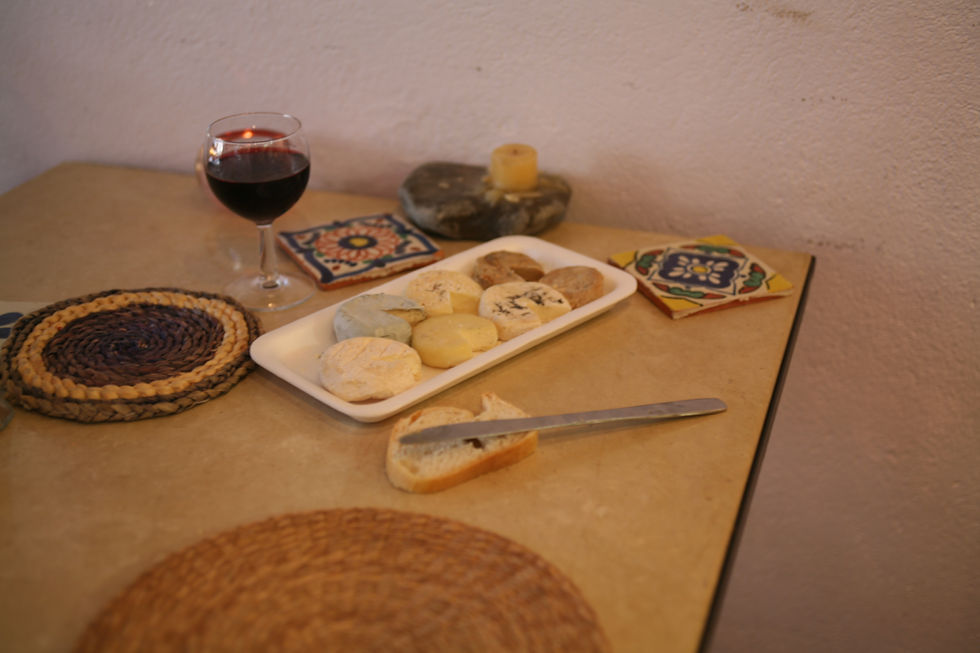(43) Fiore Sardo, an original Sardinian delicacy
- C Demeyer
- Nov 27, 2022
- 3 min read
I would like to back to cheese now and demonstrate by an example how delicious and varied cheese can be.
To be not too obvious, I decided to use an Italian product from the island of Sardinia that has been made for as long as can be remembered, and maybe even before! This is where original was use for, to emphasize the primacy of the product and its longevity. The last point is proving the quality of the cheese and the adaptability of the producers. This cheese deserves your consideration.

Roman vestiges near the Mediterranean Sea
Please find below a description of the cheese, following my usual format.
And above all, enjoy Traditional Cheese, visit your local store.
FIORE SARDO
History
Sardinia has a long history, and this cheese seems to have been part of it from the start. When the Romans arrived they noticed the production of sheep cheese on this island, and the production never stopped. It is only with the advent of the unified Italy in the nineteenth century and progress of transportation methods that there was a need to give a name to this cheese, it was present on the main part of the country from before. It seemed appropriate at the time to give an elegant name reminiscent of the nature of the product and “flower of Sardinia” felt right, due first to its ancient use in the coagulation process and then because the cheese was shipped in barrels with a flower mark.
It was adopted mostly by the people of the continent first who used the cheese as ingredient for pesto. The cheese making process did not change until recently when it started to be made in large dairies, mostly due to economic pressures. It gained Italian recognition in 1974 and European status in 1996.
Area of production
The area of production of this cheese is the whole of the Autonomous Region of Sardinia on the west of mainland Italy, which enjoys a very warm Mediterranean climate, but the cheese is made from December to June. The island is very rugged, and the flora is varied with many aromatic shrubs and herbs, perfect for sheep rearing.
Production method
The milk is from the local breed of sheep called Sardo, which has been around on the island for millennia. Their diet is based on grass and shrubs, as well as the many aromatic plants and wildflowers found within the area of production; complementary feed is regulated. It is used whole and raw, from one or two milking and coagulated with addition of rennet in copper cauldron, cardoom flowers were used a long time ago. The curd mass thus obtained in about 30 minutes is cut, rested for a few minutes and then properly cut down into grains. The cheese is moulded and the curd is hand worked within the mould to help drainage of the whey. It is then gently pressed in the mould, scalded with hot water to harden the rind, and salted in a bath of brine for 36 to 48 hours. The cheese then is air-dried by a brazier using shrubs, containing usually aromatic plants, for 10 to 15 days, which imparts a light smokiness. It is moved when ready to the maturing cellar, cool humid and well-ventilated, where it will stay for at least 2 months, but usually more like 4 months and up to 8 in some case. During maturing the cheese is turned frequently and may be washed with a mix of olive oil, wine vinegar, and salt (a variant on brine), but this is not obligatory.
Taste and description
A rather tall, as large, and brownish on the outside cheese, it is hard with a touch of smoky spicy lactic aroma when cut. It feels a touch earthy with a hint of minerality combined within the smoky feel and herbal for the best production. The sweetness of the milk is well balanced with the acidity and the cheese has a distinct feel of robust elegance.
To be consumed within a week when cut, wrap in cheese paper or cling film and keep in refrigerator.
Extra information
www.madeinsouthitalytoday.com/fiore-sardo



Comments